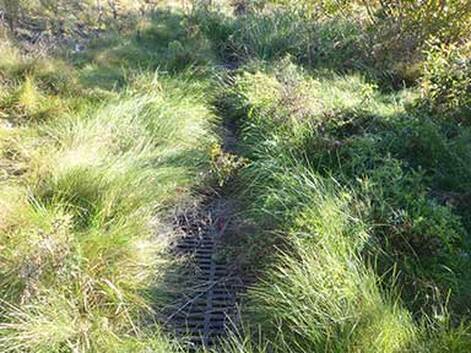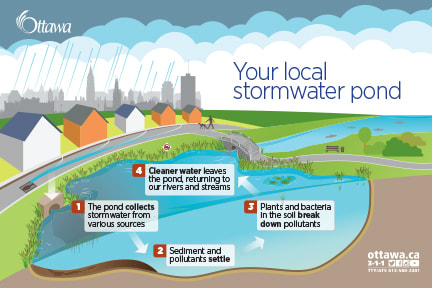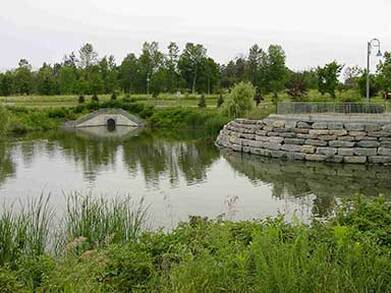April 8, 2022
Stormwater collection
Storm sewers carry rainfall and other surface runoff directly to the nearest creek, stream or river, frequently with limited or no treatment. Everyone plays a role in preventing pollutants from entering the storm sewer system and damaging the water ecosystem. Over time, stormwater collection has graduated from being concerned only with draining excess water away as quickly as possible, to flood and erosion prevention in waterways, to restoring water quality before releasing to nearby waterways.
Various practices are used to manage stormwater runoff throughout its journey from rain to river. Stormwater management begins with lot-level controls where rain first drops. It then proceeds to conveyance controls which help transport stormwater. Finally, end-of-pipe measures treat stormwater before it is discharged into our local waterways.
The City of Ottawa maintains a network of culverts, storm sewers and municipal drains that transport stormwater to nearby creeks, lakes or rivers. In Ottawa, the stormwater system includes:
Typical lot level measures include:
Stormwater collection
Storm sewers carry rainfall and other surface runoff directly to the nearest creek, stream or river, frequently with limited or no treatment. Everyone plays a role in preventing pollutants from entering the storm sewer system and damaging the water ecosystem. Over time, stormwater collection has graduated from being concerned only with draining excess water away as quickly as possible, to flood and erosion prevention in waterways, to restoring water quality before releasing to nearby waterways.
Various practices are used to manage stormwater runoff throughout its journey from rain to river. Stormwater management begins with lot-level controls where rain first drops. It then proceeds to conveyance controls which help transport stormwater. Finally, end-of-pipe measures treat stormwater before it is discharged into our local waterways.
The City of Ottawa maintains a network of culverts, storm sewers and municipal drains that transport stormwater to nearby creeks, lakes or rivers. In Ottawa, the stormwater system includes:
- More than 2,700 km of storm sewers
- More than 300 stormwater management facilities including 133 wet ponds, 100 dry ponds, 12 stormwater pumping stations, underground storage, bioswales, and oil-grit separators
- 1,200 km of municipal drains in rural areas
Typical lot level measures include:
- Downspout redirection: Downspout redirection diverts flows from roof tops to areas such as grass, gravel, or infiltration trenches. This reduces the quantity of stormwater that must be treated by reducing the amount of stormwater flowing onto impervious surfaces such as driveways which drain directly to the storm sewer system.
- Rain barrels and cisterns: Rain barrels and cisterns capture roof runoff and temporarily store it for reuse. This practice reduces runoff and pollutants, and can provide a benefit in terms of reduced water consumption.
- Rain gardens and other absorbent landscaping: Rain gardens are designed to absorb and clean stormwater by capturing runoff in human-made depressions lined with water thirsty (hydrophilic) plants and soil that encourages infiltration. This lot-level measure decreases peak flows through additional on-site storage and reduces pollutants released into the stormwater system through plant/ground absorption.
- Catch Basins: Openings along curbs and parking lots where rainwater enters the storm sewer system designed to capture heavy debris and grit. Storm sewer catch basins are usually marked with a fish to remind people that stormwater eventually makes its way into nearby waterways.
- Bioswales: Vegetated, shallow, open channels designed for conveyance and treatment of stormwater runoff, particularly from roadway drainage. Grass swales can sometimes reduce runoff volumes and pollutant loads by filtration through the vegetation. Plants are often selected due to their ability to filter sediments and nutrients.
- Infiltration Trenches: Long, narrow, rock-filled trenches that receive stormwater runoff from roadways or landscaped areas. These trenches are effective in removing fine particles and associated pollutants.
- Perforated Pipe Systems: Perforated pipes have tiny holes that allow water to filter into the surrounding soil. This measure reduces the quantity of stormwater runoff that is managed by the stormwater collection system.
- Oil-Grit Separators (OGS): An oil-grit separator (OGS) uses separate chambers to remove coarse sediments (grit), oils and other buoyant pollutants (floatables).
- Inlet Control Devices (ICDs): Much like an hour glass, ICDs are engineered to only allow a certain amount of stormwater over time. ICDs are located throughout various stormwater entry points and help manage stormwater quantity when storm sewer capacity is exceeded. ICDs prevent stormwater from discharging at critical points in the stormwater collection system and redirect it to parking lots, parks, or underground storage.
- Street Cleaning: Streets are a significant contributor of pollutants to urban runoff. Street cleaning can reduce this impact. The City of Ottawa uses tandem street cleaning machines that use brooms and vacuums to prevent debris from entering our stormwater collection system.
- Smart About Salt Program: During the winter, the City manages the use of rock salt on roads and parking lots. While this is a necessary tool to help combat Ottawa’s fluctuating winter climate, it is important to ensure we understand the impact of using too much salt. That is why the City has partnered with the Smart About Salt Council to become an active participant in the Smart About Salt Program(link is external).
- Biofilter: A biofilter uses grass or other dense plants to filter out sediment and nutrient material before re-entering local waterways. As stormwater passes through the plants, pollutants are removed. Biofilters provide treatment for pollution but do not control the amount of stormwater passing through them.
- Underground Storage Tanks: The use of underground storage tanks help control the flow of stormwater and aid in preventing flooding, erosion and combined sewer overflows. Stored water is released back into the storm sewer system at a reduced rate, decreasing the stresses placed on downstream stormwater infrastructure.
- Stormwater Ponds: Stormwater ponds receive stormwater runoff and hold the water back for a period to allow pollutants to settle before they are discharged into a watercourse. The controlled release rate also helps prevent flooding and erosion.
There are three main types of stormwater ponds in Ottawa:
- Dry Ponds: Designed to be dry most of the time and temporarily detain water to prevent overloading the storm sewer system during large storms. The stored water is released back into the storm sewer system at a reduced rate, preventing downstream flooding. These facilities are often incorporated as depressions in parks or adjacent to roadways.
- Infiltration Ponds: Collected stormwater filters into the ground, improving water quality as it slowly passes through the soil. These ponds are also capable of recharging or replenishing the groundwater table. Suitable sandy soils are required for these special facilities and are not common in the Ottawa area.
- Wet Ponds: Water levels in wet ponds rise and fall with each storm, but they always hold a certain volume of the water and may include man-made wetland features. Wet ponds are intended to mimic natural lakes and often have healthy aquatic ecosystems including fish, bird and waterfowl populations. Never consume any fish caught from a stormwater pond.
- Stay out of stormwater ponds. Recreational activities such as swimming, wading, and fishing are prohibited for your own health and safety. These ponds contain surface pollutants such as oil, metals, and feces
- Stay off the ice in the winter as water levels and flows change rapidly making skating or other activities extremely dangerous
- Protect your pet’s health and safety by keeping them out of stormwater ponds
- Vacuum, sweep, and use rags or dry absorbents on your driveway - don’t hose it down.
- Select native and adapted plants that require less fertilizer to minimize contaminated runoff.
- Apply lawn and garden chemicals sparingly and according to directions. Ontario's province-wide pesticide regulation(link is external) prohibits the sale and use of most pesticides for cosmetic purposes on lawns, gardens, park and schoolyards.
- Deposit yard waste in your green bin to prevent catch basin blockages.
- Wash vehicles at a car wash so that cleaning products do not flow directly into the storm sewers or ditches.
- Check underneath your car to ensure engine fluids are not leaking.
- Dispose of chlorinated and salt water pool wastewater using the City’s pool maintenance tips.
- Keep litter, pet waste and debris out of street gutters, storm catch basins and ditches so they are not washed directly into streams, rivers, lakes and wetlands.
- Always pick up after your pets. Stormwater will carry feces into local waterways increasing the total E. Coli and bacteria levels.
- Dispose of used oil, antifreeze, paints and other household chemicals at a household hazardous waste depot or a Take it Back! retailer, not into catch basins or ditches.
- If you’re unsure of how to dispose of any chemicals or household hazardous materials or look for a Take it Back! retailer, consult the City’s Waste Explorer(link is external).
- Take part in cleanup initiatives such as the great Canadian Shoreline Cleanup(link is external) or Ottawa’s very own bi-annual GLAD Cleaning the Capital!
- If you spot someone pouring harmful material into a catch basin, call 3-1-1.
- Ensure cigarette butts are disposed of safely in a designated spot.
- Don’t feed geese and other wildlife. One bird’s dropping can contaminate up to one acre of water.
- Maximize infiltration of rain into the soil to recharge groundwater and protect aquifers for the future.
- Reduce peak stormwater flows through rainwater-harvesting and natural landscaping. Feed your garden not the storm drain!
- Redirect your downspout to drain away from hard surfaces, such as asphalt or patio stones onto grass, gardens, or an infiltration trench.
- Install a rain barrel to use rainwater at a later date.
- Plant trees, shrubs and ground cover to reduce soil erosion and soak up water.
- Keep stormwater on your property through smart stormwater landscaping such as building a rain garden or infiltration pit.
- Reduce the amount of impermeable surfaces on your property such as patio stone or asphalt and replace with permeable options such as interlock, gravel, or grass.



